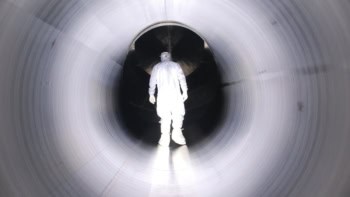An experimental technique that can test theories of strongly-interacting Fermi condensates has been developed in Austria. Physicists made precise time measurements of oscillations in the condensates to show that Monte Carlo simulations are the only current method available for accurately revealing their behaviour in the puzzling "BEC-BCS crossover" regime (Phys. Rev. Lett 98 040401).

Particles fall into two categories: bosons, which have an integer spin number, and fermions, which have a half-integer spin number. When sufficiently cooled, bosons all fall into a single ground state, collectively undergoing a transition to a so-called “Bose-Einstein condensate” (BEC). Although quantum mechanics forbids any two fermions to occupy the same state, an equivalent “Fermi condensate” can still occur when the half-spin fermions pair up and thus imitate the behaviour of single-spin bosons.
The length scale at which fermions pair up, however, has a huge impact on the behaviour of the condensate. If two fermionic atoms come close enough together to form a small molecule, they will form a BEC at low temperatures, just like bosons. But if they pair up on a much larger scale involving interactions across the whole system, forming what are known as “Cooper pairs”, the condensate is instead governed by “BCS” theory (named after its originators, John Bardeen, Leon Cooper and J Robert Schrieffer).
Physicists are currently most interested in length scales between these two extremes: the “BEC-BCS crossover” region. Because in this region fermions strongly interact with one another, there is no simple theoretical means to describe their behaviour, and therefore physicists have had to rely on methods such as “Monte Carlo” simulations (advanced computer algorithms that can tackle many-body systems), or simply extending BCS theory into the BEC regime.
Now, Rudi Grimm and his team from the University of Innsbruck have performed measurements to show that the latter of these methods cannot provide a faithful description of a strongly interacting Fermi condensate. Instead, they recommend Monte Carlo simulations as the only current means for obtaining an accurate description over the entire crossover region.
The physicists started by trapping a gas of fermionic lithium-6 atoms into a cigar-shaped geometry using lasers. They then cooled it to below 100 nanokelvin and applied a magnetic field to force the atoms to pair up as bosonic molecules. Finally, after condensing the molecules into a BEC, they carefully tuned the magnetic field to promote the molecules into the BEC-BCS crossover regime.
Grimm’s team came up with a novel technique to probe the regime’s behaviour, by momentarily “squeezing” the condensate with the trapping lasers. They could then measure the ensuing oscillation’s frequency to ascertain a better description of the system’s “equation of state” – an important characterization of underlying interactions within the condensate.
“Our work shows that the experiments on ultracold Fermi gases have now reached a stage where one can really perform meaningful tests of many-body quantum theories,” Grimm told Physics Web. “This is important as these theories are very difficult and usually rely on certain assumptions, the justification of which is not fully clear.”




